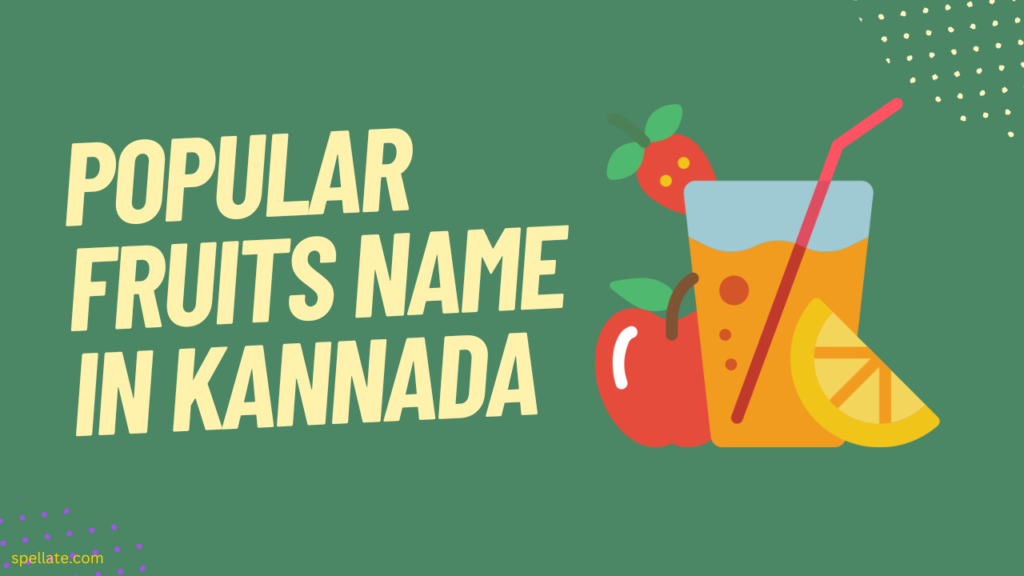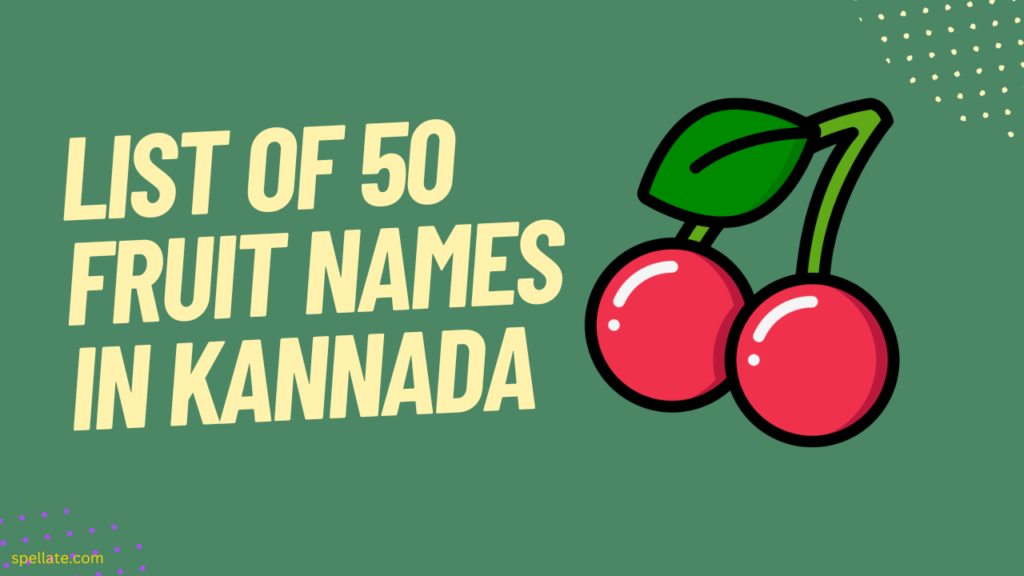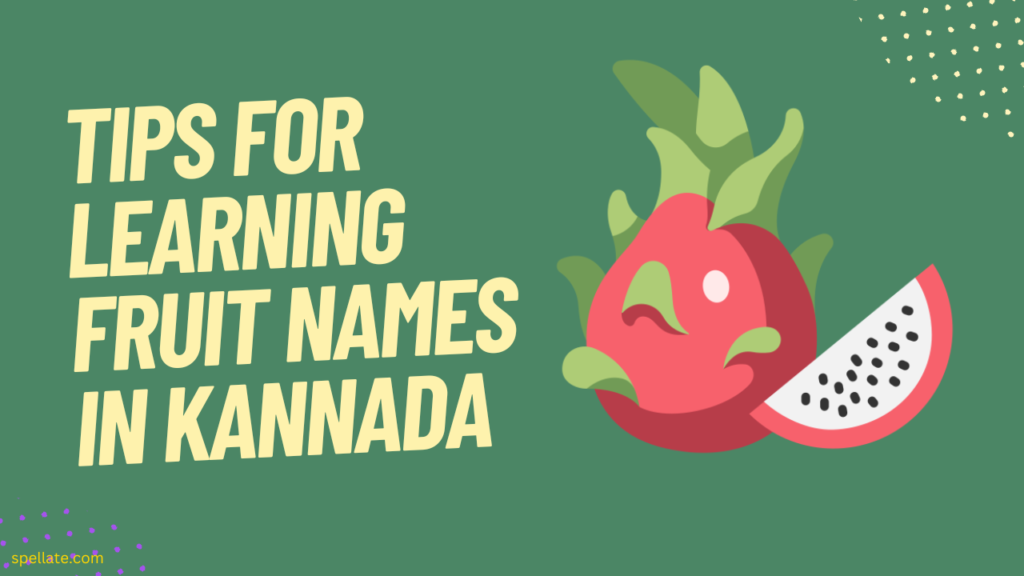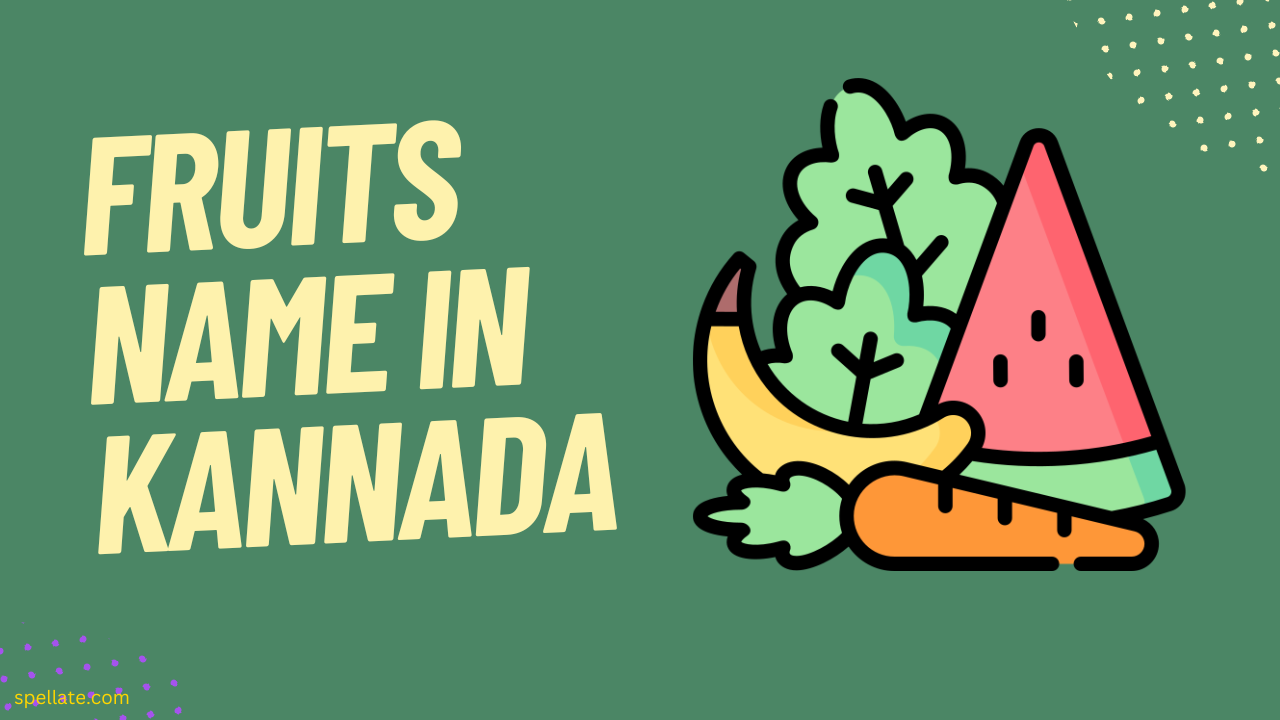Welcome to the fascinating world of fruits! In this guide, we will explore the vibrant and diverse array of fruits found in the beautiful language of Kannada. Kannada is one of the oldest Dravidian languages spoken primarily in the Indian state of Karnataka, and it boasts a rich cultural heritage that extends to its culinary traditions.
Fruits are not only a delicious and refreshing treat but also an essential part of a healthy diet. Knowing the fruits name in Kannada can be incredibly helpful, whether you are planning a trip to Karnataka, are interested in learning a new language, or simply have a curiosity for the regional variations of fruit names.
Kannada has a unique way of naming fruits, with each name capturing the essence of the fruit’s characteristics and qualities. From the tangy and juicy oranges to the sweet and succulent mangoes, the diversity of fruits in Kannada is truly remarkable. This guide will provide you with an extensive list of fruits and their corresponding names in Kannada, enabling you to expand your vocabulary and appreciate the cultural significance of these fruits.
So, whether you are a language enthusiast, a traveler, or simply someone seeking to broaden your knowledge, join us as we embark on a flavorful journey through the fascinating world of fruits in Kannada. Get ready to savor the linguistic and gastronomic delights that await you as we uncover the delightful names of fruits in this enchanting language.
- Popular fruits name in Kannada
- 1. Banana – ಬಾಳೆ ಹಣ್ಣು (Bāḷe haṇṇu):
- 2. Mango – ಮಾವಿನ ಹಣ್ಣು (Māvina haṇṇu):
- 3. Apple – ಸೇಬು (Sēbu):
- 4. Orange – ಕಿತ್ತಳೆ ಹಣ್ಣು (Kittale haṇṇu):
- 5. Pineapple – ಅನಾನಸ (Anānas):
- 6. Grapes – ದ್ರಾಕ್ಷಿ ಹಣ್ಣು (Drākṣi haṇṇu):
- 7. Watermelon – ಕಲ್ಲಂಗಡಿ ಹಣ್ಣು (Kallangadi haṇṇu):
- 8. Papaya – ಪಪಾಯ (Papāya):
- 9. Pomegranate – ದಾಳಿಂಬೆ ಹಣ್ಣು (Dāḷimbe haṇṇu):
- 10. Guava – ಪೇರಲ ಹಣ್ಣು (Pērala haṇṇu):
- 11. Jackfruit – ಹಲಸಿನ ಹಣ್ಣು (Halasina haṇṇu):
- 12. Coconut – ತೆಂಗಿನ ಕಾಯಿ (Teṅgina kāyi):
- 13. Custard apple – ಸೀತಾಫಲ (Sītāphala):
- 14. Lemon – ನಿಂಬೆಹಣ್ಣು (Nimbehaṇṇu):
- 15. Sapota – ಸಪೋಟ (Sapōṭa):
- List of 50 fruit names in Kannada
Popular fruits name in Kannada

Karnataka, the land of Kannada, is known for its rich culture and food. Kannada, as a language, has a significant influence on the culinary traditions of the state. Fruits are an essential part of Kannadiga cuisine and are consumed in various forms – as desserts or snacks or even in main dishes. Here are some popular fruits name in Kannada:
1. Banana – ಬಾಳೆ ಹಣ್ಣು (Bāḷe haṇṇu):
Bananas are a widely popular and nutritious fruit known for their distinctive shape and sweet taste. In Kannada, bananas are referred to as “ಬಾಳೆ ಹಣ್ಣು” (Bāḷe haṇṇu). The term “ಬಾಳೆ” (Bāḷe) refers specifically to bananas, while “ಹಣ್ಣು” (haṇṇu) translates to “fruit.” Bananas are not only a delicious snack but also a great source of essential nutrients, such as potassium, vitamin C, and dietary fiber. They are widely cultivated in Karnataka and are a staple fruit in many households.
2. Mango – ಮಾವಿನ ಹಣ್ಣು (Māvina haṇṇu):
Mangoes are often hailed as the “king of fruits” due to their luscious taste and rich flavor. In Kannada, mangoes are known as “ಮಾವಿನ ಹಣ್ಣು” (Māvina haṇṇu). The term “ಮಾವಿನ” (Māvina) specifically refers to mangoes, and “ಹಣ್ಣು” (haṇṇu) denotes “fruit.” Karnataka, with its favorable climatic conditions, is renowned for producing a wide variety of mangoes, cherished for their juiciness, sweetness, and distinct aroma. Mangoes are not only a popular fruit but also an integral part of Kannada cuisine, featuring in a variety of dishes, desserts, and beverages.
3. Apple – ಸೇಬು (Sēbu):
Apples are globally recognized for their crisp texture and refreshing taste. In Kannada, apples are referred to as “ಸೇಬು” (Sēbu). The term “ಸೇಬು” (Sēbu) directly represents the fruit. Although apples are not native to Karnataka, they have gained popularity and are widely consumed for their nutritional benefits. Apples are known for their high fiber content and various vitamins, making them a healthy choice for a snack or as an ingredient in salads and desserts. The term “ಸೇಬು” (Sēbu) is borrowed from Hindi and is commonly used in Kannada to denote this particular fruit.
4. Orange – ಕಿತ್ತಳೆ ಹಣ್ಣು (Kittale haṇṇu):
Oranges are vibrant citrus fruits known for their tangy flavor and high vitamin C content. In Kannada, oranges are called “ಕಿತ್ತಳೆ ಹಣ್ಣು” (Kittale haṇṇu). The term “ಕಿತ್ತಳೆ” (Kittale) specifically refers to oranges, while “ಹಣ್ಣು” (haṇṇu) means “fruit.” Oranges are widely enjoyed as a refreshing snack and are also used in juices, desserts, and various culinary preparations. They are a popular fruit in Karnataka and are cultivated in different regions of the state.
5. Pineapple – ಅನಾನಸ (Anānas):
Pineapples are tropical fruits known for their sweet and tangy taste, as well as their spiky exterior. In Kannada, pineapples are referred to as “ಅನಾನಸ” (Anānas). The term “ಅನಾನಸ” (Anānas) is derived from the English word “pineapple.” Pineapples are cultivated in certain regions of Karnataka and are enjoyed for their juicy texture and distinct flavor. They can be eaten fresh, used in salads, or incorporated into various dishes, desserts, and beverages.
6. Grapes – ದ್ರಾಕ್ಷಿ ಹಣ್ಣು (Drākṣi haṇṇu):
Grapes are small, round fruits that grow in clusters and are known for their sweet and tart taste. In Kannada, grapes are known as “ದ್ರಾಕ್ಷಿ ಹಣ್ಣು” (Drākṣi haṇṇu). The term “ದ್ರಾಕ್ಷಿ” (Drākṣi) specifically refers to grapes, while “ಹಣ್ಣು” (haṇṇu) means “fruit.” Grapes are grown in vineyards across Karnataka, and the state is renowned for its wine production. Grapes are not only enjoyed as a snack but also used to make juice, wine, and various other grape-based products.
7. Watermelon – ಕಲ್ಲಂಗಡಿ ಹಣ್ಣು (Kallangadi haṇṇu):
Watermelon is a juicy and refreshing fruit known for its vibrant red flesh and high water content. In Kannada, watermelon is referred to as “ಕಲ್ಲಂಗಡಿ ಹಣ್ಣು” (Kallangadi haṇṇu). The term “ಕಲ್ಲಂಗಡಿ” (Kallangadi) specifically denotes watermelon, while “ಹಣ್ಣು” (haṇṇu) means “fruit.” Watermelons are popular during the hot summer months and are enjoyed for their sweet taste and hydrating properties. They are commonly consumed as a refreshing snack, in salads, or in the form of juices and smoothies.
8. Papaya – ಪಪಾಯ (Papāya):
Papaya is a tropical fruit known for its vibrant orange flesh and unique flavor. In Kannada, papaya is called “ಪಪಾಯ” (Papāya). The term “ಪಪಾಯ” (Papāya) directly represents the fruit. Papayas are rich in vitamins, minerals, and digestive enzymes, making them a nutritious choice. They can be eaten fresh or used in various culinary preparations such as salads, smoothies, and desserts. Karnataka’s warm climate allows for the cultivation of papayas, and they are commonly found in local markets.
9. Pomegranate – ದಾಳಿಂಬೆ ಹಣ್ಣು (Dāḷimbe haṇṇu):
The pomegranate is a unique fruit known for its ruby-red seeds packed with a sweet and tart flavor. In Kannada, pomegranate is referred to as “ದಾಳಿಂಬೆ ಹಣ್ಣು” (Dāḷimbe haṇṇu). The term “ದಾಳಿಂಬೆ” (Dāḷimbe) specifically represents pomegranate, while “ಹಣ್ಣು” (haṇṇu) means “fruit.” Pomegranates are not only delicious but also rich in antioxidants and other beneficial nutrients. They can be consumed fresh, juiced, or used as a topping in various dishes, salads, and desserts. Pomegranate trees thrive in the diverse climatic conditions of Karnataka, and the fruit is widely grown and enjoyed throughout the state.
10. Guava – ಪೇರಲ ಹಣ್ಣು (Pērala haṇṇu):
Guava is a tropical fruit known for its sweet and tangy flavor and distinctive aroma. In Kannada, guava is known as “ಪೇರಲ ಹಣ್ಣು” (Pērala haṇṇu). The term “ಪೇರಲ” (Pērala) specifically represents guava, while “ಹಣ್ಣು” (haṇṇu) means “fruit.” Guavas are commonly found in Karnataka, and they are enjoyed as a refreshing snack or used in various culinary preparations such as juices, jams, jellies, and desserts.
11. Jackfruit – ಹಲಸಿನ ಹಣ್ಣು (Halasina haṇṇu):
Jackfruit is a large tropical fruit with a sweet and distinct flavor, often used as a meat substitute in vegetarian dishes due to its meaty texture. In Kannada, jackfruit is called “ಹಲಸಿನ ಹಣ್ಣು” (Halasina haṇṇu). The term “ಹಲಸಿನ” (Halasina) specifically refers to jackfruit, while “ಹಣ್ಣು” (haṇṇu) means “fruit.” Karnataka is known for its abundant jackfruit production, and the fruit is used in various savory and sweet preparations, including curries, chips, desserts, and ice creams.
12. Coconut – ತೆಂಗಿನ ಕಾಯಿ (Teṅgina kāyi):
Coconut is a versatile fruit widely appreciated for its unique taste and numerous uses. In Kannada, coconut is referred to as “ತೆಂಗಿನ ಕಾಯಿ” (Teṅgina kāyi). The term “ತೆಂಗಿನ” (Teṅgina) specifically represents coconut, while “ಕಾಯಿ” (kāyi) means “fruit.” Coconuts are an integral part of Karnataka’s cuisine and culture, with the state being abundant in coconut trees. The fruit is used for its water, flesh, and oil in a wide range of dishes, beverages, and sweets, and its leaves are used for various purposes such as packaging and cooking.
13. Custard apple – ಸೀತಾಫಲ (Sītāphala):
Custard apple, also known as sugar apple, is a tropical fruit with a creamy and sweet pulp that is highly aromatic. In Kannada, the custard apple is called “ಸೀತಾಫಲ” (Sītāphala). The term “ಸೀತಾಫಲ” (Sītāphala) directly represents the fruit. Custard apples are native to Karnataka and are enjoyed for their unique taste and texture. The fruit is typically eaten fresh, and its pulp is used in desserts, ice creams, milkshakes, and smoothies.
14. Lemon – ನಿಂಬೆಹಣ್ಣು (Nimbehaṇṇu):
Lemon is a citrus fruit known for its sour taste and acidic juice, which adds a tangy flavor to various dishes and beverages. In Kannada, lemons are called “ನಿಂಬೆಹಣ್ಣು” (Nimbehaṇṇu). The term “ನಿಂಬೆಹಣ್ಣು” (Nimbehaṇṇu) combines “ನಿಂಬೆ” (Nimbe), which specifically represents lemons, and “ಹಣ್ಣು” (haṇṇu), meaning “fruit.” Lemons are widely used in cooking, baking, and as a flavoring agent in beverages. They are also known for their high vitamin C content and various health benefits.
You May Also Like
15. Sapota – ಸಪೋಟ (Sapōṭa):
Sapota, also known as chikoo or sapodilla, is a tropical fruit with a sweet and caramel-like flavor and a custard-like texture. In Kannada, sapota is called “ಸಪೋಟ” (Sapōṭa). The term “ಸಪೋಟ” (Sapōṭa) directly represents the fruit. Sapota is popular in Karnataka and is eaten fresh or used in desserts, milkshakes, and ice creams. The fruit is known for its high dietary fiber content and is a good source of vitamins and minerals.
List of 50 fruit names in Kannada

Kannada is a language spoken in the southern Indian state of Karnataka, and it has a rich cultural heritage. One of the many elements that contribute to this heritage is the extensive knowledge of local fruits, which are used in traditional recipes and medicine. In fact, there are over 50 different fruits name in Kannada alone! These fruits come in all shapes and sizes, ranging from tiny berries to large melons. Here’s a list of 50 fruit names in Kannada:
| No | English | Kannada |
| 1 | Apple | ಸೇಬು (Sēbu) |
| 2 | Mango | ಮಾವಿನ ಹಣ್ಣು (Māvina haṇṇu) |
| 3 | Banana | ಬಾಳೆ ಹಣ್ಣು (Bāḷe haṇṇu) |
| 4 | Orange | ಕಿತ್ತಳೆ ಹಣ್ಣು (Kittale haṇṇu) |
| 5 | Grapes | ದ್ರಾಕ್ಷಿ ಹಣ್ಣು (Drākṣi haṇṇu) |
| 6 | Watermelon | ಕಲ್ಲಂಗಡಿ ಹಣ್ಣು (Kallangadi haṇṇu) |
| 7 | Papaya | ಪಪಾಯ (Papāya) |
| 8 | Pomegranate | ದಾಳಿಂಬೆ ಹಣ್ಣು (Dāḷimbe haṇṇu) |
| 9 | Guava | ಪೇರಲ ಹಣ್ಣು (Pērala haṇṇu) |
| 10 | Jackfruit | ಹಲಸಿನ ಹಣ್ಣು (Halasina haṇṇu) |
| 11 | Coconut | ತೆಂಗಿನ ಕಾಯಿ (Teṅgina kāyi) |
| 12 | Custard Apple | ಸೀತಾಫಲ (Sītāphala) |
| 13 | Lemon | ನಿಂಬೆಹಣ್ಣು (Nimbehaṇṇu) |
| 14 | Sapota | ಸಪೋಟ (Sapōṭa) |
| 15 | Pineapple | ಅನಾನಸ (Anānas) |
| 16 | Strawberry | ಸ್ಟ್ರಾಬೆರಿ (Sṭrāberi) |
| 17 | Kiwi | ಕಿವಿ (Kivi) |
| 18 | Avocado | ಆವಕಾಡೊ (Āvakāḍo) |
| 19 | Raspberry | ರಾಸ್ಬೆರಿ (Rāsberi) |
| 20 | Blackberry | ಬ್ಲ್ಯಾಕ್ಬೆರಿ (Blākberi) |
| 21 | Blueberry | ಬ್ಲೂಬೆರಿ (Blūberi) |
| 22 | Cranberry | ಕ್ರ್ಯಾನ್ಬೆರಿ (Kryānberi) |
| 23 | Fig | ಅಂಜೂರ (Anjūra) |
| 24 | Apricot | ಏಪ್ರಿಕಾಟ್ (Ēprikāṭ) |
| 25 | Plum | ಪ್ಲಂ (Plaṃ) |
| 26 | Pear | ಪಿಯರ್ (Piyar) |
| 27 | Peach | ಪೀಚ್ (Pīc) |
| 28 | Lychee | ಲೈಚಿ (Laichi) |
| 29 | Papaya | ಪಪಾಯ (Papāya) |
| 30 | Raspberry | ರಾಸ್ಬೆರಿ (Rāsberi) |
| 31 | Blackberry | ಬ್ಲ್ಯಾಕ್ಬೆರಿ (Blākberi) |
| 32 | Blueberry | ಬ್ಲೂಬೆರಿ (Blūberi) |
| 33 | Cranberry | ಕ್ರ್ಯಾನ್ಬೆರಿ (Kryānberi) |
| 34 | Fig | ಅಂಜೂರ (Anjūra) |
| 35 | Apricot | ಏಪ್ರಿಕಾಟ್ (Ēprikāṭ) |
| 36 | Plum | ಪ್ಲಂ (Plaṃ) |
| 37 | Pear | ಪಿಯರ್ (Piyar) |
| 38 | Peach | ಪೀಚ್ (Pīc) |
| 39 | Lychee | ಲೈಚಿ (Laichi) |
| 40 | Blackcurrant | ಬ್ಲ್ಯಾಕ್ಕರೆಂಟ್ (Blākkareṇṭ) |
| 41 | Gooseberry | ನೆಲ್ಲಿಕಾಯಿ (Nellikāyi) |
| 42 | Elderberry | ಎಲ್ಡರ್ಬೆರಿ (Elḍarberi) |
| 43 | Mulberry | ಮಲ್ಬೆರಿ (Malberi) |
| 44 | Date | ಖಜೂರ್ (Khajūr) |
| 45 | Kiwifruit | ಕಿವಿಹಣ್ಣು (Kivihannu) |
| 46 | Dragon fruit | ಡ್ರಾಗನ್ ಹಣ್ಣು (Ḍrāgan haṇṇu) |
| 47 | Passion fruit | ಪ್ಯಾಷನ್ ಹಣ್ಣು (Pyāśan haṇṇu) |
| 48 | Tamarind | ಹುಣಸೆಹಣ್ಣು (Huṇasehaṇṇu) |
| 49 | Persimmon | ಪರ್ಸಿಮನ್ ಹಣ್ಣು (Parsiman haṇṇu) |
| 50 | Guava | ಪೇರಲ ಹಣ್ಣು (Pērala haṇṇu) |
| 51 | Star fruit | ಸ್ಟಾರ್ ಹಣ್ಣು (Sṭār haṇṇu) |
| 52 | Jamun | ನೇರಳೆಹಣ್ಣು (Neralahaṇṇu) |
| 53 | Wood apple | ಬೇಲದಹಣ್ಣು (Bēladahaṇṇu) |
| 54 | Indian gooseberry | ನೆಲ್ಲಿಕಾಯಿ (Nellikāyi) |
Importance of Knowing Fruits Names in Kannada
Kannada is a vibrant language, spoken by millions of people primarily in the southern Indian state of Karnataka. Knowing fruits name in Kannada can be a significant advantage for locals and tourists alike. Fruits are an essential part of our diet as they offer vital nutrients to keep us healthy. Knowing the names of fruits in Kannada is important for several reasons:
Communication:
If you are in a Kannada-speaking region or interacting with Kannada-speaking individuals, knowing the names of fruits in Kannada enables effective communication. You can easily express your preferences, ask for specific fruits, or engage in conversations related to fruits.
Cultural Understanding:
Language is deeply intertwined with culture. Learning the names of fruits in Kannada helps you understand the local culture and traditions associated with these fruits. It allows you to appreciate and participate in local customs, festivals, and culinary practices that revolve around fruits.
Shopping and Dining:
When shopping for fruits in a Kannada-speaking area, knowing the names in Kannada helps you navigate local markets and communicate with vendors more efficiently. It ensures that you can identify and purchase the fruits you desire. Similarly, when dining out or ordering fruit-based dishes, knowing the names in Kannada allows you to make informed choices from the menu.
Health and Nutrition:
Fruits are essential for a healthy diet, providing vital nutrients, vitamins, and fiber. Knowing the fruits name in Kannada helps you make informed decisions about incorporating them into your meals. It enables you to diversify your fruit intake, ensuring a balanced and nutritious diet.
Cultural Exchange:
If you are interested in learning about different languages and cultures, knowing the fruits name in Kannada contributes to your linguistic knowledge. It allows you to engage in cultural exchange, share your own fruit-related experiences, and learn from others about the significance of fruits in Kannada culture.
Tips for Learning Fruit Names in Kannada

Learning fruit names in Kannada can be an exciting and enriching experience. Here are some tips to help you in your journey:
1. Start with Basic Fruits: Begin by learning the names of commonly consumed fruits such as banana, apple, mango, and orange. These are widely known and will provide a solid foundation for further learning.
2. Use Visual Aids: Visual aids such as pictures, flashcards, or charts displaying the fruits and their Kannada names can be highly effective in associating the visual representation with the corresponding word in Kannada. You can create your own flashcards or find online resources to assist you.
3. Practice Pronunciation: Pay attention to the correct pronunciation of the fruits name in Kannada. Listen to native speakers pronouncing the words and try to imitate their pronunciation. Practice speaking the names aloud to improve your pronunciation and fluency.
4. Create Vocabulary Lists: Keep a list of fruits name in Kannada and review them regularly. Write down the English names alongside the Kannada names for better comprehension. Make it a habit to revisit and revise the vocabulary list to reinforce your learning.
5. Contextualize Learning: Associate fruit names in Kannada with real-life situations. For example, when you visit a fruit market or grocery store, try to identify and name the fruits in Kannada. This hands-on experience will enhance your understanding and retention of the vocabulary.
6. Use Mobile Apps or Online Resources: There are several language learning apps and websites that provide interactive lessons, quizzes, and games for learning Kannada fruit names. Utilize these resources to make your learning process engaging and enjoyable.
7. Practice Conversations: Engage in conversations with native Kannada speakers or language exchange partners. Use the fruits name in Kannada while discussing fruits, recipes, or preferences. Practicing conversations will help you reinforce your vocabulary and build confidence in using the language.
8. Explore Cultural Resources: Immerse yourself in Kannada culture by exploring regional recipes, literature, or videos that showcase fruits and their significance in Kannada traditions. This will provide a deeper understanding of the cultural context and make the learning experience more meaningful.
9. Be Consistent and Patient: Learning a new language takes time and effort. Set aside dedicated time for learning fruit names in Kannada and be consistent in your practice. Celebrate small achievements and be patient with yourself as you progress.
10. Have Fun and Experiment: Learning should be enjoyable! Experiment with different learning techniques, such as creating mnemonic devices or associating fruits with personal anecdotes or stories. Embrace the process, have fun, and celebrate your progress along the way.
Final Thoughts
In conclusion, learning the names of fruits in Kannada is a valuable endeavor that brings numerous benefits. It enhances communication, and cultural understanding, and facilitates seamless interactions in a Kannada-speaking environment. By expanding your vocabulary, you can navigate local markets, make informed choices, and engage in conversations about fruits.
Additionally, learning fruits name in Kannada promotes cultural exchange, fosters a deeper appreciation for Kannada traditions, and allows for a broader understanding of the language. With the help of visual aids, practice, and immersion in Kannada culture, you can make steady progress in your learning journey. Embrace the process, stay consistent, and enjoy the excitement of acquiring new language skills.
FAQs
Are there any online communities or language exchange platforms where I can practice fruit names in Kannada?
Yes, there are language exchange platforms and online communities where you can connect with Kannada speakers. You can engage in conversations, practice fruits name in Kannada, and receive guidance from native speakers.
Are there any regional variations in fruit names in Kannada?
Yes, there can be regional variations in Kannada fruit names. Some fruits may have multiple names or specific names used in different regions or dialects. It’s helpful to consult local resources or native speakers for accurate regional variations.
